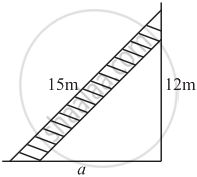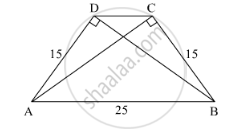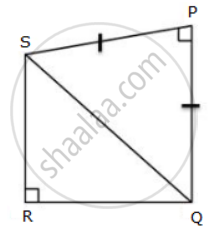Advertisements
Advertisements
Question
Prove that the area of the equilateral triangle drawn on the hypotenuse of a right angled triangle is equal to the sum of the areas of the equilateral triangles drawn on the other two sides of the triangle.
Solution

Let a right triangle BAC in which ∠A is right angle and AC = y, AB = x.
Three equilateral triangles ΔAEC, ΔAFB and ΔCBD are drawn on the three sides of ΔABC.
Again, let area of triangles made on AC, AB and BC are A1, A2 and A3, respectively.
To prove: A3 = A1 + A2
Proof: In ΔCAB,
By pythagoras theorem,
BC2 = AC2 + AB2
⇒ BC2 = y2 + x2
⇒ BC = `sqrt(y^2 + x^2)`
We know that,
Area of an equilateral triangle = `sqrt(3)/4 ("Side")^2`
∴ Area of equilateral ΔAEC,
A1 = `sqrt(3)/4 ("AC")^2`
⇒ A1 = `sqrt(3)/4 y^2` ...(i)
And area of equilateral ΔAFB,
A2 = `sqrt(3)/4 ("AB")^2`
= `(sqrt(3)x^2)/4` ...(ii)
Area of equilateral ΔCBD,
A3 = `sqrt(3)/4 ("CB")^2`
= `sqrt(3)/4 (y^2 + x^2)`
= `sqrt(3)/4 y^2 + sqrt(3)/4 x^2`
= A1 + A2 ...[From equations (i) and (ii)]
⇒ A3 = A1 + A2
Hence proved.
APPEARS IN
RELATED QUESTIONS
ABC is an equilateral triangle of side 2a. Find each of its altitudes.
A 15 m long ladder reached a window 12 m high from the ground on placing it against a wall at a distance a. Find the distance of the foot of the ladder from the wall.

Walls of two buildings on either side of a street are parallel to each other. A ladder 5.8 m long is placed on the street such that its top just reaches the window of a building at the height of 4 m. On turning the ladder over to the other side of the street, its top touches the window of the other building at a height 4.2 m. Find the width of the street.
In a trapezium ABCD, seg AB || seg DC seg BD ⊥ seg AD, seg AC ⊥ seg BC, If AD = 15, BC = 15 and AB = 25. Find A(▢ABCD)

In right angle ΔABC, if ∠B = 90°, AB = 6, BC = 8, then find AC.
In the figure, given below, AD ⊥ BC.
Prove that: c2 = a2 + b2 - 2ax.
If P and Q are the points on side CA and CB respectively of ΔABC, right angled at C, prove that (AQ2 + BP2 ) = (AB2 + PQ2)
Prove that `(sin θ + cosec θ)^2 + (cos θ + sec θ)^2 = 7 + tan^2 θ + cot^2 θ`.
In a triangle ABC, AC > AB, D is the midpoint BC, and AE ⊥ BC. Prove that: AB2 + AC2 = 2AD2 + `(1)/(2)"BC"^2`
In the given figure. PQ = PS, P =R = 90°. RS = 20 cm and QR = 21 cm. Find the length of PQ correct to two decimal places.
